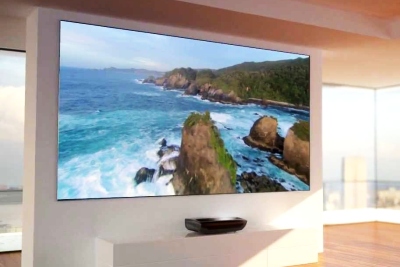
On November 20th, Miji Technology, a leading domestic manufacturer of laser non-screen TVs, secured Baidu's lead round C financing, becoming the focus of attention in China. Just three days later, Hisense launched a range of 4K laser TVs, further fueling the demand for laser TVs as an alternative to traditional LCD models. Laser TV, also known as a laser projector, is essentially a device that uses a reflective ultra-short-focus projection technology. It consists of two main components: a reflective ultra-short-focus projector and a specialized projection screen. The term "television" is used because it employs a laser light source, which offers superior performance compared to traditional projectors, including a light-resistant screen, ultra-short focusing capabilities, and the ability to be placed directly on a TV cabinet.
However, due to high costs, laser TVs are still considered a niche product. They mainly cater to home theater enthusiasts and have not yet replaced conventional projectors or LCD TVs. The question remains: is the industry focused on laser TV projectors or actual televisions?
In essence, "laser television" is simply a projector with a laser light source and a light-resistant screen, giving the traditional projector a new lease on life. However, some manufacturers and media outlets tend to exaggerate the potential of laser TVs, highlighting their limitations and shortcomings. Currently, laser TVs are more of a conceptual and experimental product rather than a mainstream solution. While they offer advantages over large LCD screens, it’s unreasonable to compare them directly with LCDs, as the true TV experience is defined by size and quality. A laser TV is still fundamentally a projector, and without both the screen and the projector, it loses its identity as a "TV."
Laser TVs are a complex solution integrating projection technology, light-resistant screens, sound systems, and smart features. They are not just simple projectors but a simplified version of a television. Their primary goal is to provide a high-quality viewing experience, but achieving this requires expensive components like professional anti-light curtains, making them unaffordable for most consumers. The cost of excellent daytime performance comes at the expense of high prices, which many users find unjustified.
From a technical perspective, scanning deflection in laser TVs poses challenges. Similar to CRT technology, the laser beam scans the entire image line by line, resulting in high-speed rotation of internal components. This leads to issues like noise, lubrication, and maintenance costs, making mass-market adoption difficult. Additionally, many laser projectors lack smart systems, limiting their ability to support modern features like voice recognition or facial detection. Resolution is another concern—many so-called 4K laser TVs actually use 1080P lenses, making the "4K" label misleading.
Considering typical home setups, 70-inch LCD TVs are often the largest choice for most households. Larger sizes may not be practical due to viewing distance limitations. For example, a 150-inch 4K TV would require a minimum of 3-5 meters of space, making it suitable only for spacious living rooms or luxury homes. Many consumers overlook this factor, leading to uncomfortable viewing experiences despite the impressive size.
Another challenge is brightness. Projectors rely on reflected light, making brightness measurements tricky. While manufacturers claim high lumens, real-world performance often falls short. Anti-light screen technology helps, but it comes at the cost of reduced brightness. Most laser TVs currently achieve only 200–250 nits, far below the standards of LCDs and OLEDs. To reach 360 nits on a 120-inch screen, a projector would need over 6,000 lumens, which is costly and impractical for most users.
Color accuracy is another issue. Most laser TVs use a blue laser and a yellow fluorescent wheel to create white light, resulting in poor color gamut and potential color drift. While two-color lasers (blue + red) improve image quality, they remain expensive and rare in consumer models. High-end options like Hisense’s dual-color T1 can cost up to 80,000 yuan, making them inaccessible for average families.
In summary, while laser TVs show promise, they are still in the early stages of development. Their high cost, technical limitations, and practical challenges mean they remain a luxury item for the elite rather than a household staple. Until these issues are addressed, they will continue to be a niche product, confined to high-end homes and special settings.
In terms of display effect, the advantages of OLED screens are too attractive compared to LCD screens. The OLED screen has the function of individually controlling the pixels. In daily use, not every scene needs to light up all the pixels of the screen. Therefore, it can display a more pure black effect, and can also achieve 1000000:1 in terms of contrast ratio, so that the bright places are bright enough, and the dark places are very dark, bringing a more realistic display effect.
In addition, compared with LCD screens, OLED screens have removed components such as backlights and polarizers. In terms of sliding and touch, OLED screens can provide a touch response speed of 0.2ms, and dynamic content such as content sliding and games. In the scene, the OLED screen can provide a clearer look and feel.
It is precisely because of this that more and more notebook manufacturers are beginning to deploy and promote OLED screens on their own products to further improve the display effect of their own products. Among the notebook computer manufacturers, ASUS is the most active. The slogan of #ASUSscreen# has been played before, and with the help of high-quality OLED screens, it brings a more amazing display effect than LCD. The recently launched new product, the ASUS Unparalleled series, has brought the 120Hz high-brush OLED screen to the 5K price range, reducing the dimension of products at the same price.
0.96Inch Oled,0.96Inch Oled Display,OLED screens,Lcd Panel Oled Display
ESEN HK LIMITED , https://www.esenlcd.com